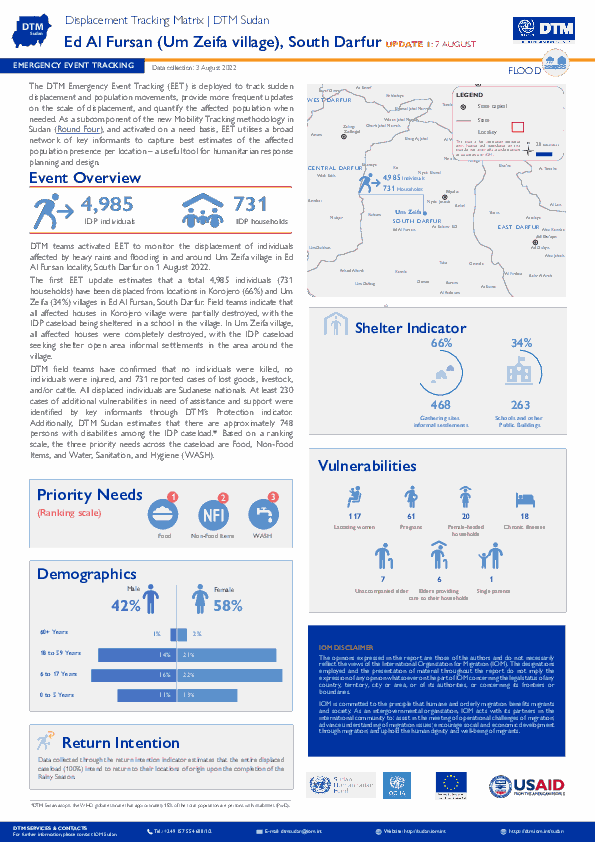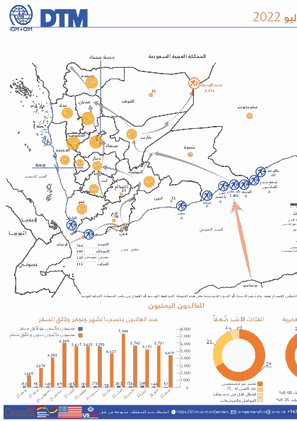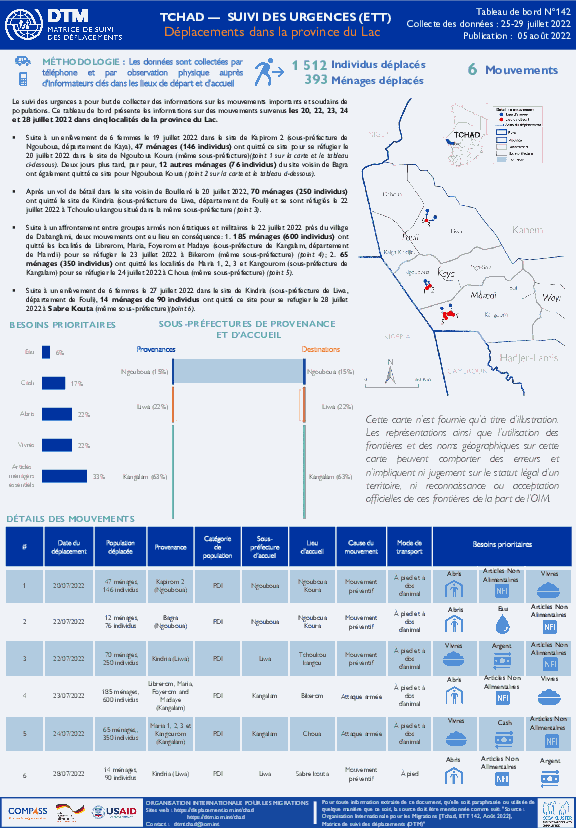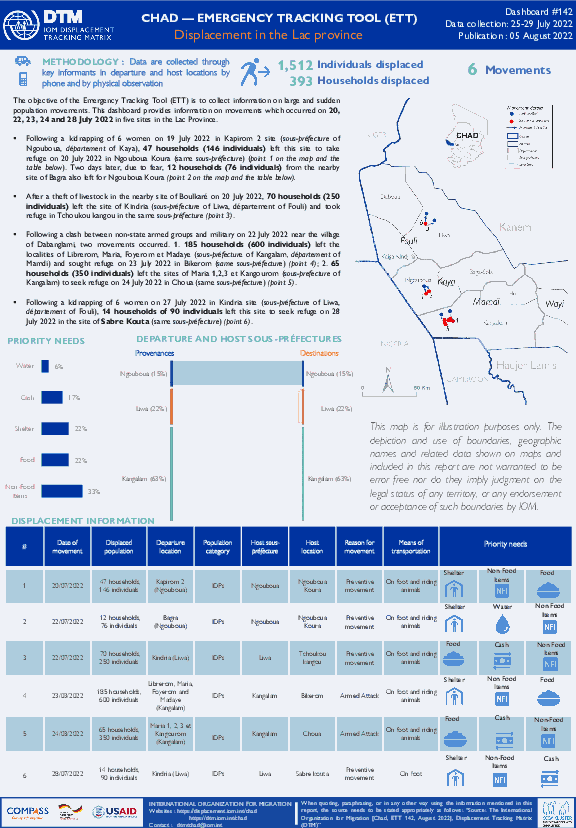-
Countries
-
Data and Analysis
-
Special Focus
-
Crisis Responses

Contact
DTM Sudan; dtmsudan@iom.int
Language
English
Location
Sudan
Snapshot Date
Aug 03 2022
Activity
- Mobility Tracking
- Event Tracking
The DTM Emergency Event Tracking (EET) is deployed to track sudden displacement and population movements, provide more frequent updates on the scale of displacement, and quantify the affected population when needed. As a subcomponent of the new Mobility Tracking methodology in Sudan (Round Four), and activated on a need basis, EET utilises a broad network of key informants to capture best estimates of the affected population presence per location – a useful tool for humanitarian response planning and design.
Contact
DTM Yemen, iomyemendtm@iom.int
Location
Yemen
Activity
- Flow Monitoring
Period Covered
Jul 01 2022 -Jul 31 2022
In July 2022, IOM Yemen DTM recorded 3,171 migrants entering Yemen, similar to 3,174 in June 2022. In both Shabwah and Lahj DTM has registered a decrease in arrivals since February 2022 although a slight increase has been observed in Shabwah this June compared to the last months. The overall decrease is in part linked to seasonal weather conditions as well as an increase in border patrols from the Djibouti side, especially near Lahj meaning smaller boats with fewer migrants made their way to Yemen. The slight increase in Shabwah can be attributed to the urgent need to send as much as possible of migrants from Bosasso, Somalia to Shabwah, Yemen because the windy season is approaching and it will be difficult for migrants to travel at that period.
Moreover, DTM recorded 4,476 Yemeni returns from KSA during the month of July 2022, compared to 5,895 in June 2022.
Between 1 January and 31 July 2022, DTM recorded 34,437 migrants and 39,761 Yemeni migrant returnees to Yemen.
The migrant caseload was around 93 per cent Ethiopian nationals, and around 7 per cent Somali nationals. The migrants are predominantly male (71%), with (20%) women, six per cent boys and three per cent girls also among the travelers.
Through July’s reporting period, 1,622 migrants arrived from Somalia and were recorded about 1,602 at Ber Ali flow monitoring point in Shabwah governorate and 20 migrants at Dhalooma flow monitoring point in Hadramawt governorate. In Lahj governorate, 1,549 migrants arrived from Djibouti, where 764 were recorded at Al Cawhah flow monitoring point (FMP), 540 at Al Makhabbah FMP, 130 at Hasy Eisa FMP, and 115 at Al Azaf FMP.
Population Groups
Survey Methodology
Unit of Analysis Or Observation
Type of Survey or Assessment
Keywords
Geographical Scope
Administrative boundaries with available data
The current dataset covers the following administrative boundaries

Contact
DTM Yemen, iomyemendtm@iom.int
Language
Arabic
Location
Yemen
Period Covered
Jul 01 2022
Jul 31 2022
Activity
- Flow Monitoring
في يوليو 2022 ، سجلت مصفوفة تتبع النزوح (DTM) التابعة للمنظمة الدولية للهجرة في اليمن 3,171 مهاجرًا دخلوا اليمن ، مقارنة بـ 3,174 مهاجرًا في يونيو 2022. في كل من شبوة ولحج ، سجلت مصفوفة تتبع النزوح انخفاضًا في عدد الوافدين منذ فبراير 2022 على الرغم من ملاحظة زيادة طفيفة في شبوة في يوليو و يونيو مقارنة بشهر مايو وما قبله. ويرتبط الانخفاض الإجمالي جزئياً باحوال الطقس الموسمية بالإضافة إلى زيادة الدوريات الحدودية في الجانب الجيبوتي ، وخاصة بالقرب من لحج ، مما يعني أن القوارب الأصغر التي يقل عدد المهاجرين فيها قد شقت طريقها إلى اليمن. يمكن أن تعزى الزيادة الطفيفة في شبوة إلى الحاجة الملحة لإرسال أكبر عدد ممكن من المهاجرين من بوساسو بالصومال إلى شبوة باليمن لأن موسم الرياح يقترب وسيكون من الصعب على المهاجرين السفر في تلك الفترة.
بالإضافة إلى ذلك ، سجلت مصفوفة تتبع النزوح في اليمن حوالي 4,476 يمني عادوا من المملكة العربية السعودية خلال شهر يوليو، مقارنة بـ 5,895 في يونيو 2022. خلال الفترة بين 1 يناير و 31 يوليو 2022، وصل ما يقدر بـ 34,437 مهاجرًا و 39,761 يمنيًا عائداً إلى اليمن.
حيث مثل عدد المهاجرين من إثيوبيا93 % في المائة و 7 في المائة من الصوماليين. كانت غالبية المهاجرين من الذكور (71%) مع (20%) من النساء ، و ستة في المائة من الأولاد و ثلاثة في المائة من الفتيات اللواتي كنا ايضاً من ضمن المسافرين.
خلال فترة التقرير في يوليو 2022، شوهد وصول 1,622 مهاجرا من الصومال وتم تسجيل 1,602 في نقطة مراقبة التدفق في بئر علي في محافظة شبوة و 20 مهاجرا في نقطة مراقبة التدفق بظلومه بمحافظة حضرموت. بينما شهدت نقاط مراقبة التدفق بمديرية المضاربة والعارة بمحافظة لحج وصول عدد 1,549 مهاجرا وصلوا من جيبوتي , حيث تم تسجيل 764 في الكوحه ؛ وا 540 في المخاباه ؛وا 130 في حسي عيسى ؛ وا 115 في العزاف.

Contact
DTM Yemen, iomyemendtm@iom.int
Language
English
Location
Yemen
Period Covered
Jul 01 2022
Jul 31 2022
Activity
- Flow Monitoring
In July 2022, IOM Yemen DTM recorded 3,171 migrants entering Yemen, similar to 3,174 in June 2022. In both Shabwah and Lahj DTM has registered a decrease in arrivals since February 2022 although a slight increase has been observed in Shabwah this June compared to the last months. The overall decrease is in part linked to seasonal weather conditions as well as an increase in border patrols from the Djibouti side, especially near Lahj meaning smaller boats with fewer migrants made their way to Yemen. The slight increase in Shabwah can be attributed to the urgent need to send as much as possible of migrants from Bosasso, Somalia to Shabwah, Yemen because the windy season is approaching and it will be difficult for migrants to travel at that period.
Moreover, DTM recorded 4,476 Yemeni returns from KSA during the month of July 2022, compared to 5,895 in June 2022. Between 1 January and 31 July 2022, DTM recorded 34,437 migrants and 39,761 Yemeni migrant returnees to Yemen.
The migrant caseload was around 93 per cent Ethiopian nationals, and around 7 per cent Somali nationals. The migrants are predominantly male (71%), with (20%) women, six per cent boys and three per cent girls also among the travelers.
Through July’s reporting period, 1,622 migrants arrived from Somalia and were recorded about 1,602 at Ber Ali flow monitoring point in Shabwah governorate and 20 migrants at Dhalooma flow monitoring point in Hadramawt governorate. In Lahj governorate, 1,549 migrants arrived from Djibouti, where 764 were recorded at Al Cawhah flow monitoring point (FMP), 540 at Al Makhabbah FMP, 130 at Hasy Eisa FMP, and 115 at Al Azaf FMP.

Contact
DTM Tchad, dtmtchad@iom.int
Language
French
Location
Chad
Period Covered
Jul 20 2022
Jul 28 2022
Activity
- Mobility Tracking
- Event Tracking
Le suivi des urgences a pour but de collecter des informations sur les mouvements importants et soudains de populations. Les données sont collectées par téléphone et par observation physique auprès d'informateurs clés dans les lieux de départ et d'accueil. Ce tableau de bord présente les informations sur 6 mouvements survenus les 20, 22, 23, 24 et 28 juillet 2022 dans cinq localités de la province du Lac.

Contact
DTM Chad, dtmtchad@iom.int
Language
English
Location
Chad
Period Covered
Jul 20 2022
Jul 28 2022
Activity
- Mobility Tracking
- Event Tracking
The objective of the Emergency Tracking Tool (ETT) is to collect information on large and sudden population movements. Data are collected through key informants in departure and host locations by phone and by physical observation. This dashboard provides information on 6 movements which occurred on 20, 22, 23, 24 and 28 July 2022 in five sites in the Lac Province.

Contact
DTM Guinée, oimguineedtm@iom.int
Language
French
Location
Guinea
Period Covered
Apr 01 2022
Jun 30 2022
Activity
- Survey
- Flow Monitoring Survey
- Flow Monitoring
Le suivi des flux, qui est mis en œuvre en étroite collaboration avec les autorités et des partenaires nationaux et locaux, est composé de deux outils : l’enregistrement des flux (Flow Monitoring Registry, FMR), qui recueille des données clés sur l’ampleur, la provenance, la destination et les modalités des flux, et les enquêtes individuelles (Flow Monitoring Survey, FMS), conduites auprès des voyageurs afin d’obtenir des informations sur les profils, les parcours migratoires et les intentions des migrants. Le suivi des flux de populations récolte ainsi des données clés sur les flux et les tendances migratoires, les profils des voyageurs, les parcours et intentions des migrants, afin de fournir une meilleure compréhension des mobilités en Afrique de l’Ouest et du Centre.
En Guinée, la DTM recueille des données au niveau de trois point de suivi des flux (Flow Monitoring Point, FMP) a savoir : le FMP de Boundoufourdou dans la préfecture de Koundara au Nord du pays, les FMPs de Kourémalé et de Nafadji tous situés dans la préfecture de Siguiri au Nord-Est de la Guinée, dans le but d’identifier les zones à forte mobilité transfrontalière et récolter des données sur les tendances de mobilité, les profiles et les parcours des voyageurs dans le pays.
Ce rapport présente les données collectées pendant le deuxième trimestre de l’année 2022 au niveau des différents FMP actifs en Guinée.
Contact
DTM Ethiopia, SLOAddisAbabaDTM@iom.int
Location
Ethiopia
Activity
- Mobility Tracking
- Site Assessment
- Village Assessment
Period Covered
Jan 10 2022 -Apr 09 2022
A village assessment survey (VAS) is a sub-component of mobility tracking. It collects data on returning IDPs, IDPs, returned migrants and host community members. VAS evaluates the absorption capacity of villages to receive returning IDPs with a focus on accessibility of services, livelihoods and reintegration.
Population Groups
Survey Methodology
Unit of Analysis Or Observation
Type of Survey or Assessment
Keywords
Geographical Scope
Administrative boundaries with available data
The current dataset covers the following administrative boundaries
Contact
DTM Ethiopia, SLOAddisAbabaDTM@iom.int
Location
Ethiopia
Activity
- Mobility Tracking
- Site Assessment
Period Covered
Mar 01 2022 -Apr 18 2022
A site assessment is a sub-component of mobility tracking. It aims to collect data on population presence, living conditions and needs in a particular displacement site or community.
Population Groups
Survey Methodology
Unit of Analysis Or Observation
Type of Survey or Assessment
Keywords
Geographical Scope
Administrative boundaries with available data
The current dataset covers the following administrative boundaries

Contact
DTM Ethiopia, SLOAddisAbabaDTM@iom.int
Language
English
Location
Ethiopia
Period Covered
Mar 01 2022
Apr 18 2022
Activity
- Mobility Tracking
- Site Assessment
- Village Assessment
In order to capture the displacement and return dynamics in Ethiopia, DTM Ethiopia's National Displacement Report combines findings from its Site Assessment (SA) in Section 1 and findings from the Village Assessment Survey (VAS) in Section 2. The Site Assessment tracks the number of internally displaced persons (IDPs), while the Village Assessment Survey tracks the number of IDPs who are returning or have returned to their communities.
As of April 2022, a total of 2.75 million IDPs have been identified in 2,158 accessible sites across 11 regions in Ethiopia. As a note, due to operational constraints, figures from Tigray region were not included in the total. Of the displaced population, the main causes of displacement were conflict which displaced 1.78 million IDPs (65%), drought which displaced 581,952 IDPs (21%), social tension which displaced 150,576 IDPs (5%), flash floods which displaced 107,816 IDPs (4%) and seasonal floods which displaced 94,118 IDPs (3%).
Through Village Assessment Survey round 12 (March-April 2022), a total of 1.66 million returning IDPs were identified in 1,403 villages across 9 regions (data collection was not undertaken in Tigray region due to a lack of fuel and cash). 1.6 million returning IDPs (97%) were initially displaced due to conflict, 22,107 returning IDPs (1%) were initially displaced due to seasonal floods, 17,178 returning IDPs due to flash floods (1%), 3,439 returning IDPs due to landslides (<1%) and 737 returning IDPs due to fire (<1%).
